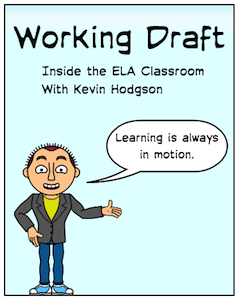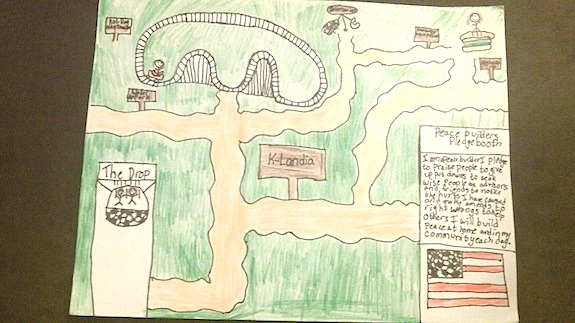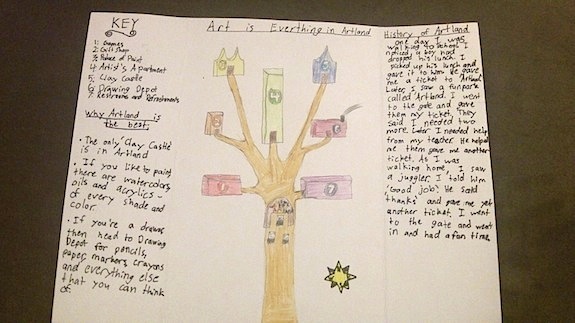Helping Middle Graders Unpack “Peacebuilding”
A MiddleWeb Blog
by Kevin Hodgson
Our school is part of PeaceBuilders, a network dedicated to “creating safe, positive learning environments.” It’s our social-curriculum framework for talking with students about community, friendship, and bullying. Every single morning, the entire school recites the PeaceBuilder’s Pledge in one collective voice.
I am a Peace Builder.
I Pledge:
To give up put-downs
To seek wise people
To notice and speak up about hurts I have caused
To right wrongs
To help others.
I will build peace at home, at school, and in my community each day.
These are the words we say each day, but as I look around my classroom each morning, it becomes clear that many students are mouthing the pledge, almost absentmindedly.
It’s not that we have a school with significant social conflict and bullying problems that overshadow everything. We don’t, although we don’t live in some unworldly bubble either. But the ideals manifested in the PeaceBuilder’s Pledge are values that our school holds to be true: being kind to others, reaching out for help when you need it, extending the peace from school to home, and making amends when necessary for your actions.
So when I see those words coming off my students’ lips in the morning and realize the meaning is clearly getting lost in the repetition, it bothers me.
At the very least, I want my students to become more aware of what they are being asked to pledge in this large school community, and why they should find what they say about peace to be important. (The Pledge of Allegiance is another example of the collective drone each morning, but I won’t get into that political bramble right now.)
Our PeaceBuilder-friendly project
A few years ago, I started to think about how I could get my students to step back from the Peacebuilder’s Pledge and examine what it is they are really saying. One year, we did promotional webcomics on the various elements of the pledge. But in recent years, I’ve been embedding the PeaceBuilder Pledge concepts into a larger project known as the Imaginary Land Brochure, or as it has been renamed and rebranded, The Peaceful Imaginary Land Brochure project.
This writing activity covers a lot of literacy ground – from analyzing non-fiction text (travel brochures as information) to map making, creative writing, and presentation to an audience. Adding in the peaceful element was just another layer of learning.
In their writing projects, which culminate in a travel brochure for an imaginary place, my students have to use at least three elements of the PeaceBuilder’s Pledge. This leads to a deep and rich discussion about the pledge, why we say it together each morning, and the various elements that help make our school a welcoming place for everyone. We break the pledge down, line by line, word by word, for analysis.
I give them plenty of room for how they can include the theme of peace in their projects, and some are very creative. While a few will name their entire imaginary land after a peaceful idea, others “bake the concepts in” to the brochure, from establishing peaceful outposts where visitors can get advice to putting in greeting stations where you earn points or currency to continue on in the land to sending a strong anti-bullying message to all visitors.
One entry point to a complex issue
I am not so naive as to think that a single writing project, such as the Peaceful Imaginary Lands Travel Brochure, can be the sole entry to understanding how to get along with others.
It takes constant discussions, and reminders, and modeling. It takes caring adults at school and at home to understand the psychology of children, and to take into consideration the baggage so many of our kids bring to school from home. It’s complex on so many levels.
But if doing a class project like this sparks discussions about how we interact with others, and if it helps them understand the words we speak each morning as a single community, then it has truly been successful.
Peace, love and understanding
As it turns out, our talented art teacher also does her own peace-inspired projects at the start of the year and her teaching becomes a natural partner to our writing project. Her Peace Poster activity, which is sponsored by the Lions Club, spurs students on to create art that represents an annual theme of peace without words or writing. Just art and symbols and design.
This year, the theme is “Peace, Love and Understanding” and the representation of student ideas is wonderful to see. Our school hallways are now lined with these posters, and with the artistic statements that they wrote in my writing classroom. Many also volunteered to podcast their artist statements. It’s inspiring to hear their voices and see their artwork as we walk the halls, realizing that we’ve found a few more ways to talk about peace in a positive manner with young students.




































